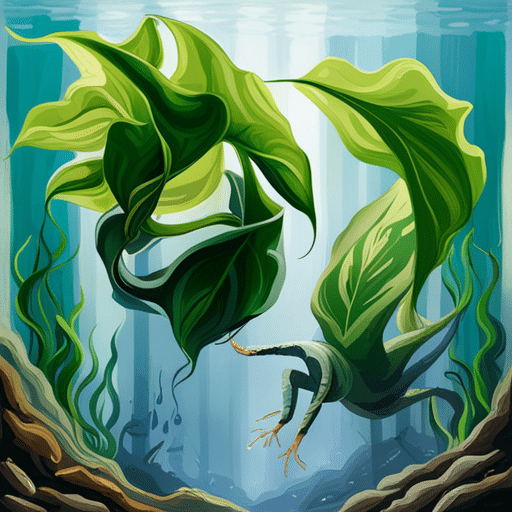Table of Contents
I. Introduction
Aquarists are always looking for new and interesting ways to make their aquariums healthy and beautiful places for their marine pets to live. In this guide, we’ll talk about some unusual ways to take care of an aquarium and how they affect your tank. These include using pothos and spider plants, not changing the water, play sand, the size of a 150-gallon aquarium, and whether or not Gorilla Glue is safe.
II. Pothos in Aquariums
A. The impact of pothos on aquariums
Pothos is a common houseplant that is known for its ability to grow in water and clean the air around it. When put in a tank, pothos can work as a natural filter by soaking up nitrates and other dangerous chemicals. This may improve the quality of the water.
B. Benefits and drawbacks
Pothos can be a good addition to your tank, but it also has some bad points. One big problem is that the plant might get more nutrients than other watery plants. Also, pothos can spread too quickly, covering the water’s surface and blocking light, which hurts the growth of other plants and the environment as a whole.

III. Spider Plants in Aquariums
A. The effect of spider plants on aquatic ecosystems
Like pothos, spider plants can be used in tanks because they can grow with some of their roots in the water. But each has a different effect on the water system. Spider plants are known for cleaning the air by getting rid of harmful chemicals like formaldehyde, benzene, and carbon monoxide.
B. Advantages and disadvantages
The main benefit of spider plants in tanks is that they can get rid of harmful chemicals and clean the air around the tank. But spider plants need enough light, which can be hard to provide in some aquariums. Also, spider plants might not have as much of an effect on the quality of the water as pothos.
IV. No Water Change Aquariums
A. The concept behind no water change aquariums
No change of water Aquariums use a careful mix of natural processes to keep the water clean, so they don’t have to change the water very often. This method needs a carefully planned ecosystem with good bugs, living plants, and a limited number of fish all working together to make an environment that can take care of itself.
B. Pros and cons of this approach
The main benefit of an aquarium that doesn’t need water changes is that it needs less care, which can be good for aquarium users who are busy. But finding the right mix can be hard, and problems with water quality are more likely if tracking isn’t done regularly. It’s important to keep a close eye on the water and be ready to take action if needed.

V. Play Sand in Aquariums
A. Utilizing play sand in aquariums
Aquarium sand or rocks can be expensive, but you can save money by using play sand instead. It can make the bottom of your tank look nice and natural, and it can also be a good place for fish that burrow and live on the floor.
B. The impact on the aquatic environment
Play sand can be a cheap choice, but it may need extra work, like a thorough washing, to keep the water from getting cloudy. Also, play sand can get hard over time, creating areas with no oxygen that can hurt the fish in a tank. To keep the surroundings healthy, it is important to do upkeep and checks on a regular basis.
VI. 150-Gallon Aquarium Dimensions
A. Understanding the space requirements
A 150-gallon aquarium is a big tank that needs to be set up with careful planning. Most of the time, these tanks are about 72 inches long, 18 inches wide, and 28 inches tall. But sizes can be a little different based on who makes the item.
B. How to choose the right aquarium
When choosing a 150-gallon aquarium, you should think about how much room you have, what kind of fish you want to keep, and how you want the tank to look overall. It’s also important to spend money on a strong stand and the tools needed to hold the weight and keep the water at the right temperature.
VII. Gorilla Glue in Aquariums
A. Assessing the safety of Gorilla Glue for aquarium use
Gorilla Glue is a famous glue, but it’s not clear if it’s safe to use in a tank. Some people say they’ve used it without any problems, but it’s usually not a good idea because it could be poisonous and could get bigger when it gets wet, which could cause structural problems.
B. Alternative adhesives for aquariums
For a better choice, you could use aquarium-safe silicone glues that are made to be used in water. These items are safe for your fish and other aquatic life because they don’t hurt them.
C. Care of Pothos Plant
To take care of a Pothos plant:
Light: Place the Pothos plant in bright, indirect light. It can tolerate low light conditions, but it thrives in moderate to bright light.
Watering: Allow the top inch of soil to dry out before watering. Overwatering can lead to root rot, so it’s better to underwater than overwater. Ensure good drainage and avoid letting the plant sit in water.
Temperature and Humidity: Pothos plants prefer temperatures between 60-85°F (15-29°C) and moderate humidity levels. They can tolerate lower temperatures but are sensitive to cold drafts.
Fertilization: Feed the Pothos plant with a balanced, water-soluble fertilizer once a month during the growing season (spring and summer). Follow the instructions on the fertilizer package.
Pruning: Regular pruning helps control its size and shape. You can trim back leggy vines to encourage bushier growth. Remove any yellow or brown leaves to maintain the plant’s health.
Propagation: Pothos plants are easy to propagate. Simply cut a healthy vine below a node and place it in water or moist soil until it develops roots.
Pests and Diseases: Pothos plants are generally resistant to pests and diseases. However, watch out for spider mites and mealybugs. If infested, treat them with an appropriate insecticide or wipe the leaves with a damp cloth.
Remember to keep your Pothos plant out of reach of pets and children as it is toxic when ingested.

VIII. Conclusion
Unusual ways to care for an aquarium, like using pothos or spider plants, setups that don’t require water changes, play sand, and knowing the size of bigger tanks, can lead to unique and healthy aquatic settings. But before using these methods, it’s important to do study and think about how they might affect things. Always put the health and happiness of the animals in your tank first, and be careful when adding new things to your aquatic environment.
IX. FAQs
1. Can I use both pothos and spider plants in my aquarium?
Yes, you can put both in your tank, but keep in mind that they have different needs and could have different effects on the environment. Make sure that both plants have enough room and light to grow well.
2. Is it possible to switch from a traditional aquarium setup to a no water change system?
Yes, it is possible to switch to a system with no water changes, but it takes careful planning and tracking to set up a stable environment that can take care of itself. It’s important to add live plants, good germs, and keep the number of fish under control. Be ready to step in if the factors of the water start to change during the shift.
3. Can I use colored play sand in my aquarium?
Even though coloured play sand may look nice, it is usually not a good idea to use it in an aquarium. The colours that are used to colour the sand can get into the water and hurt the fish and the purity of the water.
4. How can I ensure that my 150-gallon aquarium is adequately supported?
Invest in a strong, high-quality stand that can hold the weight of your 150-gallon aquarium to make sure it stays in place. Also, make sure the floor can hold the weight of the tank. A full 150-gallon aquarium can weigh more than 1,500 pounds.
5. What are some other safe adhesives to use in aquariums besides aquarium-safe silicone sealants?
Besides aquarium-safe silicone sealants, cyanoacrylate (super glue) can be used in tiny amounts to adhere plants or decorations. Choose non-toxic, aquatic-safe adhesives.
6. How can I ensure the success of a no water change aquarium?
To increase the chances of success in a no water change aquarium, follow these tips:
Start with a heavily planted tank to help absorb excess nutrients and maintain water quality.
Establish a balanced ecosystem with a controlled number of fish, compatible species, and a healthy population of beneficial bacteria.
Regularly monitor water parameters, such as ammonia, nitrite, nitrate, pH, and temperature.
Use a high-quality filtration system to remove debris and help maintain water clarity.
Be patient and allow time for the ecosystem to establish itself before making any significant changes or adding new inhabitants.
Be prepared to intervene and perform water changes if necessary, especially if you notice a decline in water quality or the health of your fish.
7. How do I clean play sand before adding it to my aquarium?
To clean play sand before adding it to your aquarium, follow these steps:
Place the play sand in a large container or bucket.
Fill the container with water and stir the sand to dislodge any debris or dirt.
Pour off the dirty water, being careful not to lose any sand in the process.
Repeat the process until the water runs clear, ensuring that the sand is free of contaminants and dust.
Allow the sand to dry before adding it to your aquarium, or add it wet if you prefer.
8. How do I choose the right lighting for my aquarium with both pothos and spider plants?
To provide the right lighting for an aquarium with both pothos and spider plants, consider the following factors:
Both plants require moderate to bright light to thrive, so choose a light fixture that can provide the necessary intensity.
Select full-spectrum LED lights, as they emit a balanced range of wavelengths that can support plant growth and benefit your fish.
Consider adding a timer to your lighting setup to mimic a natural day and night cycle, giving your plants and fish a consistent schedule.
9. How often should I check the water parameters in a no water change aquarium?
A no-water-change aquarium should be checked weekly, especially during setup and stabilisation. Regular testing can help you spot problems early and make modifications to keep your fish and plants healthy.
10. How can I create a visually appealing aquarium using unconventional care methods?
To create a visually appealing aquarium while incorporating unconventional care methods, consider the following tips:
Choose a harmonious combination of plants, such as pothos and spider plants, that complement each other and create visual interest.
Select a natural-looking substrate, like play sand, to provide a pleasing aesthetic while also supporting the needs of your fish.
Arrange aquarium decorations, rocks, and driftwood to create a sense of depth and a natural, cohesive environment.
Maintain proper lighting to showcase your plants and fish while promoting healthy growth and behaviors.
Keep your aquarium clean and well-maintained, even in a no water change setup, to ensure a clear view of your aquatic inhabitants and plants.
11. Can I use other types of glue for aquarium use?
Some glues are aquarium-safe, but it’s recommended to use aquarium-safe silicone sealants or cyanoacrylate. (super glue). These goods are fish-safe. Before putting an adhesive in your tank, check the manufacturer’s instructions or ask experienced aquarium hobbyists about its safety.
12. Can I combine a no water change system with a traditional aquarium setup?
Yes, you may use no-water-change components in an aquarium. More living plants and a healthy beneficial bacteria population may prevent water fluctuations. To maintain a healthy environment, water parameters must be monitored and water changed as needed.
13. Are there any fish species that are not compatible with unconventional aquarium care methods?
Fish that need certain water conditions or are sensitive to environmental changes may not be suitable for unconventional aquarium maintenance. In a no-water-change configuration or with some plants, fish with special diets or habitats may suffer. If you’re hesitant, contact with seasoned hobbyists or aquatic specialists before introducing your fish species to an atypical aquarium arrangement.
14. How can I tell if my aquarium plants are receiving enough light?
See if your aquarium plants are getting adequate light by observing their development and health. Healthy plants have vigorous growth, bright hues, and little stress. Slow or stunted development, pale or yellowing leaves, and a propensity to grow towards the light source are signs of inadequate light.
15. Can I use unconventional care methods in a saltwater aquarium?
Saltwater aquariums can use certain alternative care methods, but not all. Pothos and spider plants may not survive in seawater. Saltwater aquariums have more intricate ecosystems and specialised water conditions, making no-water change systems harder to establish. If you’re contemplating unorthodox saltwater aquarium maintenance methods, examine their compatibility with your setup and chat with saltwater aquarium experts.









